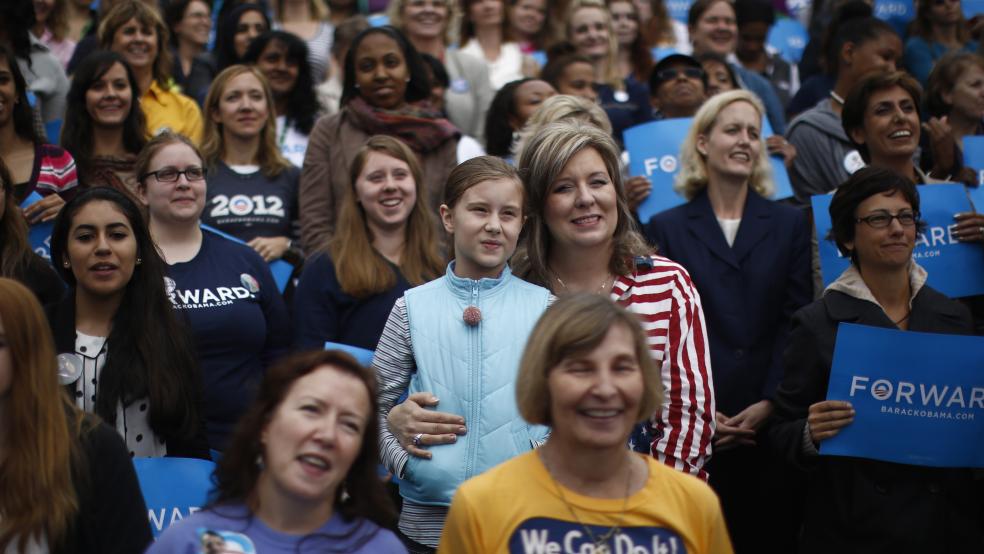In her first campaign ad for the U.S. Senate, Michigan Republican Terri Lynn Land minces no words: “Congressman Gary Peters and his buddies want you to think I’m waging a war on women,” she starts. “Reaaally? Think about that for a moment.”
Land then pauses for several seconds, shakes her head disapprovingly and waits a few more seconds before going for the knockout. “As a woman,” she says, “I might know a little bit more about women than Gary Peters.”
In the early going in races across the country, Democrats and Republicans are airing campaign ads that are all about women — how well they know them, how well they have treated or would treat them, whether they care about issues women care about, even if they are one.
Related: The Shadowy World of 'Dark Money' Campaign Spending
Land’s ad comes in response to one paid for by the Senate Majority PAC, which backs Democrats. “With Land, insurance companies will be able to deny you coverage when you get sick. Women’s access to preventive health care would be cut, while their costs would increase,” the Democratic ad alleges.
In Colorado, Democratic Sen. Mark Udall used his first television spot to accuse his opponent of waging a campaign to ban birth control. In Alaska, Julie Sullivan, whose Republican husband, Dan, is running for Senate, appears in an ad praising his record on prosecuting domestic abusers and protecting women.
And in one of the more notably negative ads this year, the Republican Governors Association slams South Carolina Democrat Vincent Sheheen, a trial lawyer who is taking on Gov. Nikki Haley, for defending “violent criminals who abused women.” The ad goes on to say, “So next time Sheheen says he’ll protect women from violent criminals, ask him, what about the ones who paid him?”
For Democrats, the approach aims to build on the success the party has had in recent elections casting Republicans as anywhere from insensitive about women’s issues to misogynistic — in what both sides refer to as a “war on women.”
Related: Nation's Airwaves Already Awash in Campaign Ads
Udall’s campaign spent about $200,000 last week and will spend another $200,000 this week on TV ads to highlight what it calls Rep. Cory Gardner’s “disturbing” record on abortion laws. “Gardner even championed an eight-year crusade to outlaw birth control, here, in Colorado,” a female narrator says in the ad.
For Republicans, 2014 is the year to fight back — not just to try to neutralize the issue but to turn it to their advantage.
“The Democratic Party runs the risk of being one-note Johnnys this cycle,” said Kellyanne Conway, a longtime Republican pollster. “Narrowcasting to women mostly on reproduction ignores a simple reality: Most women are most concerned with everyday affordability and long-term security.”
Republicans have watched with rising alarm as female voters, especially younger and unmarried ones, have moved toward Democratic hopefuls. Democrats have exploited inarticulate or sexist remarks by some Republicans and harsh antiabortion measures passed in GOP-led legislatures or sponsored by party candidates.
In Washington, Democratic lawmakers have also pushed bills designed to draw a contrast, including this month’s Paycheck Fairness Act, which died in the Senate. President Obama instead signed two executive orders designed to advance equal pay. As a result, the gender gap has grown in recent election years to Democrats’ advantage. Women make up a larger percentage of the electorate than men, they are disproportionately likely to go to the polls in midterm election years, and they are more likely to vote Democratic than men are to vote Republican.
Related: How Paycheck Fairness Can Get You Fired
Obama won among female voters by 11 points in the 2012 presidential race, while Mitt Romney won the male vote by a slimmer margin, seven points. In the Virginia gubernatorial race last year, a nine-point edge among women propelled Democrat Terry McAuliffe over Republican Ken Cuccinelli II, who won men by just three points.
Women could be particularly critical in key races this year. In a handful of states where control of the Senate will be decided, the Democratic coalition increasingly ignores white men, who have turned away from the party in recent years, in favor of identifying, persuading and turning out minority voters and white women.
A recent Quinnipiac University poll in Colorado showed Udall leading Gardner by a statistically insignificant 45 to 44 percent. What was significant was the gender gap: Udall leads among women by 17 points, while Gardner leads among men by 15.
Both parties spin their own version of political algebra that they say will work to their advantage. Though female voters outnumber male ones in midterm elections, those who turn out are more likely to be married, older, whiter and wealthier than the larger number of women who vote for president, all indicators that suggest they are more apt to lean Republican.
To turn out more of its voters, the Democratic Senatorial Campaign Committee is spending millions of dollars on identifying and targeting unmarried women, among other constituencies that are highly likely to vote Democratic but far less likely to vote in a midterm election. Add those unmarried women to a coalition that includes more minorities than usually turn out, and vulnerable Democratic senators in states such as North Carolina, Louisiana and Arkansas could have an advantage.
“These targeted women voters are harder to reach,” said Ann Liston, a Chicago-based Democratic messaging specialist. “What you are seeing from these very different races is an acknowledgment that these female voters are important in the overall targeting strategy, and these campaigns are aggressively going after them.”
The GOP math depends on blunting Democratic attacks and appealing to women more effectively. Winning a higher percentage of women’s votes, coupled with the GOP’s dominant performance among white males, would give nominees in Southern states a majority coalition.
“The irony is that Republicans have less natural support among women but more opportunity to communicate with them in 2014,” Conway said. “Republicans will talk to women about the cost, confusion, uncertainty and overreach of Obamacare, the intrusions of the IRS and NSA, and the rising costs of goods and declining value of earnings.”
A part of the Republican outreach effort has been recruiting female candidates. Land wasn’t the national party’s first choice to run for the seat of retiring Sen. Carl Levin (D) in Michigan, but her fundraising performance has impressed national strategists, and in polls she’s now even with, or slightly ahead of, Peters.
State Sen. Joni Ernst is one of the GOP’s preferred candidates in Iowa, where Sen. Tom Harkin (D) is retiring. (Ernst’s not-so-subtle first ad, titled “Squeal,” highlighted her childhood, which was spent castrating hogs.) In Oregon, Monica Wehby is helping fund her longer-shot campaign against Sen. Jeff Merkley (D).
But the GOP still faces challenges in addressing a younger generation of voters, one in which women overwhelmingly vote Democratic. The National Republican Congressional Committee let it be known last year that it was proactively teaching candidates how to speak to female voters; Democrats didn’t miss the opportunity to point out that was a subject that needed teaching. This year, Republicans will try to avoid language that might be perceived as sexist against two of the most vulnerable Democratic incumbents, Sens. Mary Landrieu (La.) and Kay Hagan (N.C.), and two women running for Republican-held seats in Kentucky and Georgia.
The electoral key lies among unmarried women, who favor Democrats by huge margins but don’t always turn out to vote, said Lara Brown, a political scientist at George Washington University’s Graduate School of Political Management. Obama won unmarried women by 36 points in 2012; Romney won among married women by seven. But in 2010, when fewer unmarried women turned out to vote, Democratic candidates for Congress won the barest plurality among women, while Republicans won among male voters by a 13-point margin.
“Democrats are at a disadvantage in midterm elections because single women, like the other demographic groups that are key to a winning Democratic coalition, are not as likely to turn out,” Brown said.
This article originally appeared in The Washington Post.
Read more at The Washington Post:
Grimm Surrenders to FBI
Who Runs Federal Agencies? Not Congress
Hillary Clinton Talks About Her Faith. Again.





